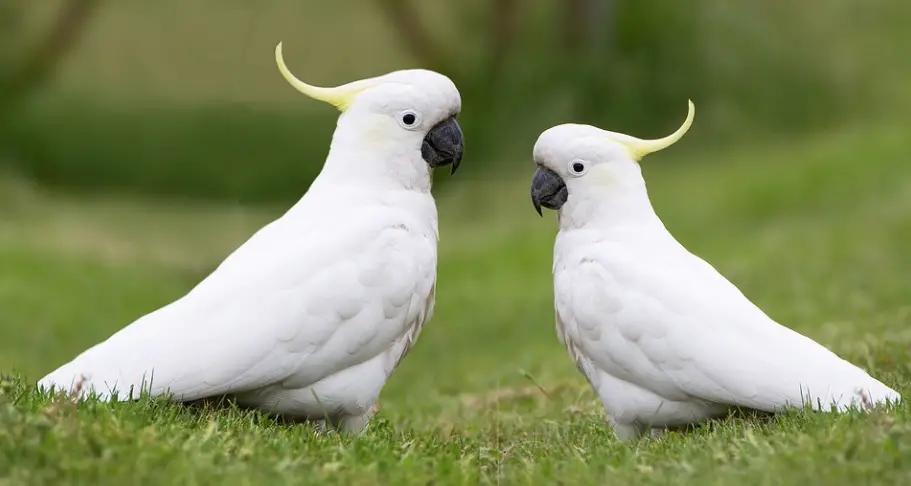Cockatoo Classification
- Kingdom: Animalia
- Phylum: Chordata
- Class: Aves
- Order: Psittaciformes
- Family: Cactuidae
- Genus: Cacatua, Probosciger, Callocephalon, Nymphicus, Calyptorhynchus, Eolophus Lophochroa
Cockatoo Description
The 21 bird species of the family Cacatuidae are referred to as Cockatoo. They are commonly known as parrots, along with two other families including Psittacoidea, and Strigopoidea. Primarily, they have an Australian range but are common in aviaries.
Most cockatoo birds consist of a defining plumage and crests and are medium-sized birds. They occur in a variety of colored features and are found in white, grey, and black colors. The size of the cockatoo ranges from about 12- 24 in (30-60 cm) in length and weighs between 0.66- 2.65 lb.
The tail feathers are long and pointed in cockatoos. They also bear a head crest that can be moved and have large wings that help to fly well, for example, some galah species can fly up to 43 mph. However several species including sulfur-crested cockatoo have smaller and rounded wings.
There are three groups or clades in the family among which the members of the genus Nymphicus are comprised of its category. The five species of genus Calyptorhyncus are characterized by black plumage and considered as the next largest category.
The largest category includes members of the genus Cacatua comprising its 11 species. The remaining four genera don’t fit into these main groups. Cockatoos have a long life, they live up to 70 years in captivity and 40 years in the wild.
Cockatoo Habitat
They have a restricted range and occur almost solely throughout Australasia. Only in Australia, 11 species occur in wild, while seven species are restricted to the islands of the Philippines, Indonesia, Papua New Guinea, and the Solomon Islands. The other three species are found in both New Guinea, and Australia.
The cockatoo species can be found in a wide range of habitats including subalpine forests and mangroves. As compare to the arid areas, species found in forests stay in a productive area due to stable food resources however several species are nomadic also.
Cockatoo Diet
Most of the Cockatoo species feed upon seeds, fruits, and insects. They are comprised of large bills and a muscular tongue that helps them to manipulate their food. To avoid predation while feeding on the ground, they often congregate with many other cockatoos.
Cockatoo Nesting and Reproduction
Cockatoos generally build their nests in tree hollows and return to the same spot after every year. They rely on insects and rotting sections of the plant to prepare a nest for them, as they are unable to make these sites.
They use sticks and leaves to protect it, especially during the breeding season. They are monogamous birds that form pairs and mate with one another for several years. In some species, females are the family planners and the primary caregivers and often rearing their young together.
At beginning of the breeding season and before nesting, they complete courtship rituals also. The copulation is followed by laying eggs in which females lay 1-8 small, white eggs. The incubation period is of about 20-29 days that followed by the birth of hatchlings, which become fledglings after 5-11 weeks and leave the nest for the first time.
The young ones strike out on their own after one year. The sexual maturity in cockatoo is relatively delayed in comparison to other bird species. Thus they gain all required skills for parenting before maturity.
Cockatoo Threats
Falcons and eagles are the primary predators of cockatoos that attack them with their talons. Many animals including snakes mammals and other birds eat their eggs and nests thus they are considered vulnerable. The primary threat for cockatoo includes habitat loss for human development.
The wild cockatoos are captures and sold in trade markets as captive-bred due to their popularity in aviaries. IUCN included several species of cockatoo into a list of vulnerable or worse. The yellow-crested cockatoo is listed as a critically endangered species.
Kingfisher: Description, Habitat, & Fun Facts
Fun Facts About Cockatoo
Cockatoos are very intelligent and also managed to thrive alongside humans, thus they are charismatic and unique.
i. A Cockatoo is a Parrot
The prominent crests and curved bills are the characteristic features of cockatoos. They belong to the family cacatuidae with 7 genera and 21 species. Members of families’ cacatuidae, Psittacoidea, and Strigopoidea are collectively called parrots.
Parrots are characterized by their zygodactyl foot that has toes facing forward and backward. The strong claw on the toe helps them to grasp onto tree branches. They also have broad wings and short legs. The true parrots or members of Psittacoidea range over a larger area than cockatoos. The Strigopoidea is commonly known as the Kakapo.
Cockatoos are found in white, grey, or black colors and are less colorful than other species of parrots that have multicolor plumage. The true parrots can talk or mimic whereas cockatoos use a complex variety of calls to communicate with each other and are unable to talk. Therefore it can be concluded that all Cockatoo species are parrots but not all parrots are cockatoos.
ii. Cockatoo Mini-Me
Cockatoos are medium-sized birds but the cockatiel is a small bird. In aviaries, all cockatoo species are common but it is quite difficult to meet their needs. The cockatiel interestingly seems to have phylogenetically diverged species. It is one of the easiest species to maintain and therefore kept as a pet or in aviaries.
iii. An Endangered Pet
Most of the cockatoo species form nests in tree hollows thus their survival is mostly threatened by habitat loss. However, several species adapted themselves and found alternative areas to make a nest in human-developed areas, for example, sulfur-crested cockatoo. Some species are also considered urban and agricultural pets in some areas.
Cockatoo Citations
- Cockatoo: https://animals.sandiegozoo.org/
- Cockatoos of Australia: https://www.natureaustralia.org.au/

